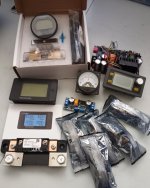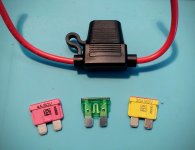It's not just a theory, it's a reality.
As long as you don't have a proprietary battery/controller with all that handshake, AI, data wire crap, it'll work fine as long as the buck converter can deliver enough amps to the controller at the correct voltage.
I can run my ebike off my bench power supply as long as I don't draw more than the 3 amp limit of my power supply.
You've got a proper waterproof, fully potted "Industrial Strength" 12 Volt Buck converter there, probably built for the automotive industry?
View attachment 188338
I spent HOURS Surfing around the internet looking for a 48 Volt version of such a device with no luck.
There might be something designed to pimp out a golf cart that can deal with the abuse that drunken

golfers

can throw at it, but I couldn't find one.
I did find a high quality MeanWell Buck Converter, but it wasn't potted and had a cooling fan. (That would blow water and dirt into it.)
And the constant vibration of an ebike would break it.
I've got a 1200 Watt 20 Amp 60 Volt Buck Converter.
It's the same one that
@Gionnirocket used to make his battery charger,..
View attachment 188339
View attachment 188340
It will take any input from 6-70 Volts and convert it into any voltage from 0-60 Volts, but there's no damn way I'm gunna plug that thing into my ebike.
Yeah sure, it's got all kinds of safety features, but it's probably even More Dangerous than those ten dollar battery blenders?
There's no way I'm gonna try pushing 1250 Watts through that thing, unless I pimped it out with thermally conductive paste and fully potted it, then put it inside a blast proof box mounted nowhere near the battery, controller, or me.
I still might try it though?
Blowing s*it up up is fun, but I'd only want to sacrifice the converter to the experiment, not the rest of my ebike, or myself, or my house.


The specs do look pretty good on paper, so in theory it should work safely, but it's designed for indoor use. (But even then I wouldn't use it unattended indoors.)
View attachment 188344
You can pick the output voltage using the DIP Switch to select either 36V or 48V depending on your battery/motor,..
View attachment 188341
Or better yet, set it to NC and dial up whatever voltage you want to send into the controller.
So I'm thinking 54.6 Volts like the controller is designed to deal with from a fully charged 48V battery,..
View attachment 188342
Then set overvoltage protection to 54.6 Volts as well so the voltage shouldn't go over that voltage (like if you bump the dial by accident.)
I wouldn't turn the voltage up any higher because Almost All 48 volt controllers use 60 volt capacitors, and feeding them 54.6 volts is even kinda too much.
A well designed circuit normally leaves 20% headroom for capacitors and 60 Volts minus 20% is 48 Volts.
I've got a cheap voltage supply powering my LED light strips that had a bad solder joint on a capacitor that could have started a fire,..
View attachment 188345View attachment 188346View attachment 188347View attachment 188348View attachment 188349
And I've got a battery charger that's always on and plugged into my e-bike in the shed that's not looking too happy

,..
View attachment 188350View attachment 188351
I don't care though.
It's an automatic charger that maintains a SLA battery so if it crapps out on me, I'm just out a $120 set of batteries that have turned into toxic waste. They might crack and leak acid all over my ebike, but it's a piece of crap anyway and I don't care.

It's been plugged in for over 3 years straight except when I go to get groceries.
View attachment 188355View attachment 188353View attachment 188354
I used Polarized two prong extension cords to make my battery connectors and wired it so that I can't plug my battery into the 120 VAC outlet.
I did however connect a Polarized two prong plug to the output of my charger, so I could plug the charger into the 120 VAC outlet, then plug the output of the charger into the same 120 VAC outlet as well.
That aughta blow sumthin up Real Good ?
And I found out recently that a fully charged lead acid battery is still good to go at -40° Celsius or Fahrenheit (same temperature on both scales) so we can still possibly start are cars at -40°, but a discharged battery (around 10 Volts) can freeze at around -2 or -3 Celcius.
So it's good to keep it plugged in.


